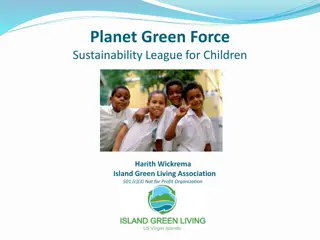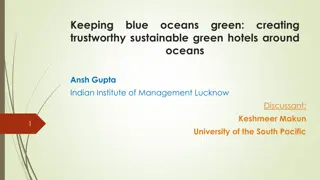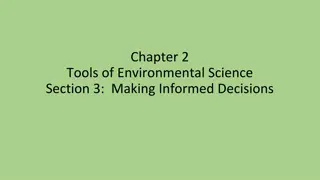
Environmental Issues: Green House Effect
The impacts of Green House Effect on animals, plants, and climate. Learn about the causes and effects of this phenomenon on Earth's ecosystem and biodiversity.
Download Presentation

Please find below an Image/Link to download the presentation.
The content on the website is provided AS IS for your information and personal use only. It may not be sold, licensed, or shared on other websites without obtaining consent from the author. If you encounter any issues during the download, it is possible that the publisher has removed the file from their server.
You are allowed to download the files provided on this website for personal or commercial use, subject to the condition that they are used lawfully. All files are the property of their respective owners.
The content on the website is provided AS IS for your information and personal use only. It may not be sold, licensed, or shared on other websites without obtaining consent from the author.
E N D
Presentation Transcript
Program CIVIL ENGINEERING Program Code CE MSBTEs E- content
Course Code 22447 Topic 1 Environment CO-a: Develop Public Awareness about Environment. Unit Outcome- UO MSBTE LEAD- STUDY AT YOUR DOORSTEP 1d, and 1e
What we will learn today 1. Agenda Agenda point point Environmental issues 2. Agenda Agenda point point Concept of 4Rs 3. Agenda Agenda point point Public awareness about environment Understand about environmental issues and Public awareness about environment. Content 1.3 Environmental issues - Ozone layer depletion and Nuclear accidents. 1.4 Concept of 4Rs Reduce, Reuse, Recycle and Recover 1.5 Public awareness about environment.
Learning Objective/ Key learning 1d. Discuss the need of public awareness about environment. 1e. Describe various environmental issues.
Concept Map Global Warming Green House Effect Environmental Issues Nuclear Accidents Climate Change Acid Rain Ozone Layer Depletion
Environmental Issues: 1. Green House Effect: The phenomenon of increase in temperature of the earth as in artificial greenhouse is called green house effect. The gases which are responsible for the greenhouse effect are called greenhouse gases. A warming of Earth s surface and troposphere (the lowest layer of the atmosphere) caused by trapping the heat in the form of infra red radiation near the earth surface by atmospheric constituents such as water vapour, carbon dioxide, methane, nitrogen oxides and Chloro Fluro Carbons. Environmental scientists estimated that the green house effect of carbon dioxide was 57%, chlorofluorocarbon was 25%, methane was 12% and that of the oxides of nitrogen was 6%.
Environmental Issues: 1. Green House Effect: Effects on animals: It has a role in spreading different types of diseases like malaria, filariasis, cholera, and diarrhoea etc due to rise in temperature. It has a role in increasing the number of vectors like insects transmitting diseases. Effects on plants: It affects water cycle, soil moisture and soil composition. As a result, there is a change in cultivation and harvesting periods of crops. Tropical plants are seen at the temperate region. It affects on yield of crops. Effects on climate: It increases the temperature of earth. It brings about the melting of ice in the Polar Regions, which increases the sea level due to which the low land coastal areas may sink and go underwater. It also changes the pattern of rainfall and weather conditions.
Environmental Issues: 2. Global Warming: Global warming is the phenomenon of rise in temperature of the earth by accumulation of green house gases. About 75% of the solar energy reaching the Earth is absorbed on the earth s surface which increases its temperature. The rest of the heat radiates back to the atmosphere. Some of the heat is trapped by greenhouse gases, mostly carbon dioxide this responds to keep the temperature warmer. Effects : Temperature increases Glaciers melt Rising ocean levels Alter forests, crop yields Affect human health Affect ecosystems Season changes
Environmental Issues: 3. Climate Change Climate is the average weather at a given point and time of year, over a long period (typically 30 years). We expect the weather to change a lot from day to day, but we expect the climate to remain relatively constant. If the climate doesn t remain constant, we call it climate change [2; 4]. Changes in: Sun s output (Solar radiation) Earth s orbit Drifting continents Volcanic eruptions Greenhouse gases
Environmental Issues: 4. Acid Rain Acid rain is basically rain that has a low Acid rain is basically rain that has a low pH. When fossil fuels such as coal, oil and natural gas are burned, chemicals like sulfur dioxide and nitrogen oxides are produced. These chemicals react with water and other chemicals in the air to form sulfuric acid, nitric acid and other harmful pollutants like sulfates and nitrates. These acid pollutants spread upwards into the atmosphere, and finally return to the ground in the form of acid rain [2; 4]. EFFECTS OF ACID RAIN EFFECTS OF ACID RAIN Acid rain is an extremely destructive form of pollution, and the environment suffers from its effects. Land, Buildings, Forests, trees, lakes, aquatic life, animals, and plants suffer from acid rain. pH.
Environmental Issues: 5. Environmental Issues: 5. Ozone Layer Depletion Troposphere: The lowest layer (about 15 km from the ground) Contains normal air composition of N2, O2, water vapour, CO2, etc. Temperature decreases with altitude. Stratosphere: Above the troposphere Temperature increases with altitude Contains a lot of ozone (ozone layer): Found in the stratosphere between 10 - 50km above the ground Protects us from the harmful effects of UV of certain wavelengths. Decrease in ozone concentration Increase in UV-B radiation reaching the earth surface. Formation of ozone layer O2 + sunlight O + O2 O + O O3
: 5. Ozone Layer Depletion Environmental Issues Environmental Issues: 5. Ozone layer in the atmosphere protects life on earth from the dangerous UV radiation from the sun. Destruction of ozone Layer Chlorine atoms from CFCs attack the ozone, taking away ozone and forming chlorine monoxide (ClO). O3 + Cl O2 + ClO Chlorine monoxide then combines with another oxygen atom to form a new oxygen molecule and a chlorine atom. ClO + O Cl + O2 The chlorine atom is free to destroy up to 100,000 ozone molecules.
: 5. Ozone Layer Depletion Environmental Issues Environmental Issues: 5. IMPACTS OF OZONE LAYER DEPLETION Sunburn. Reduce our immune system. Skin Cancer. Cataracts and Other Eye Damages. Reduce photosynthesis and crops yield affected. Damage the plants. Reduces plankton population. Reduces penguin population. Reduces the percentage of hatching of frog eggs. Forming photochemical smog. Degrades building materials.
: 6. Nuclear Accidents Environmental Issues Environmental Issues: 6. When safety measures and principles are ignored by nuclear plant operators, a nuclear accident can occurred with serious consequences for the environment, and human health. Now, efforts are made to prevent the radiation during accidents. Since 1957, ten major nuclear accidents have been reported by five countries: Fukushima, Japan - March 2011; Kashiwazaki, Japan - July 2007; Mihama, Japan - August 2004; Blayais, France - December 1999; Tokaimura, Japan - September 1999; Tokaimura, Japan - March 1997; Chernobyl, Ukraine - April 1986; Three Mile Island, USA - March 1979; The Urals, USSR - October 1958; Windscale, UK October 1957.
Environmental Issues: 6. Nuclear Accidents Impacts of Nuclear Accidents develop cancer , deaths , Species extinction, Alteration of DNA, Residual radioactivity in environment (environmental pollution), High fever, diarrhoea, fatigue, mortality, infection bleeding etc., Skin diseases, Disturb aquatic life, Long term effects on environment. Source: Pedraza , 2013
What are the solutions to all these problems?
Environmental Management: Sustainable Development Solid waste Management Hazards mitigation World Energy conservation Conservation strategy HEALTHY ENVIRONMENT Environmental Laws Pollution control Water Resources Rain water Harvesting Biodiversity conservation
Environmental Issues: ?
Concept of 4Rs Reduce: Prevent generation of waste in the first place; by eliminating waste at source through better planning and design. Don t use a resource if there is an alternative. (Donate old things; Take good care of your things; choose walking / cycling than driving; Use glassware than paper wares). Reuse: Use a resource again and again without changing it or reprocessing it for different functions than what they are intended. (Old news papers used for packing; Plastic and steel containers used for plantation etc). Recycle: Reproduce / remanufacture the new material by using recyclable waste as raw material in its parent industry. (Paper, Glass, Plastic, Metal, Rubber etc). Recover: Producing usable products or energy by processing / treating the waste. (biogas, fertilizer, Waste to energy etc). Benefits of 4R s Reduces waste, Reduces pollution, Saves energy, Saves resources, Improves economy, Creates employment.
Public awareness about environment Educate the people about environmental studies. Participation of people in environmental issues. Implementation of principle of 4R s Adoption of eco-friendly technology. Conserve the resources. Follow various acts on environment. Practice and promote good civic sense and hygiene. Practice and promote to Reduce pollution. Join local movements that support activities like saving trees in your area, go on nature treks, recycle waste, buy environmentally friendly products. Join a group to study nature, such as WWF-1 or another environmental group.
Public awareness about environment Let s Together Build a World In Which Every Person Has . And Lives in Safe Adequate water Sanitation Hygienic Environment
2 The conservation of natural resources A.Was not encouraged in ancient India B.was encouraged in ancient india. C.Is recently being used in India D.None of these 24






















